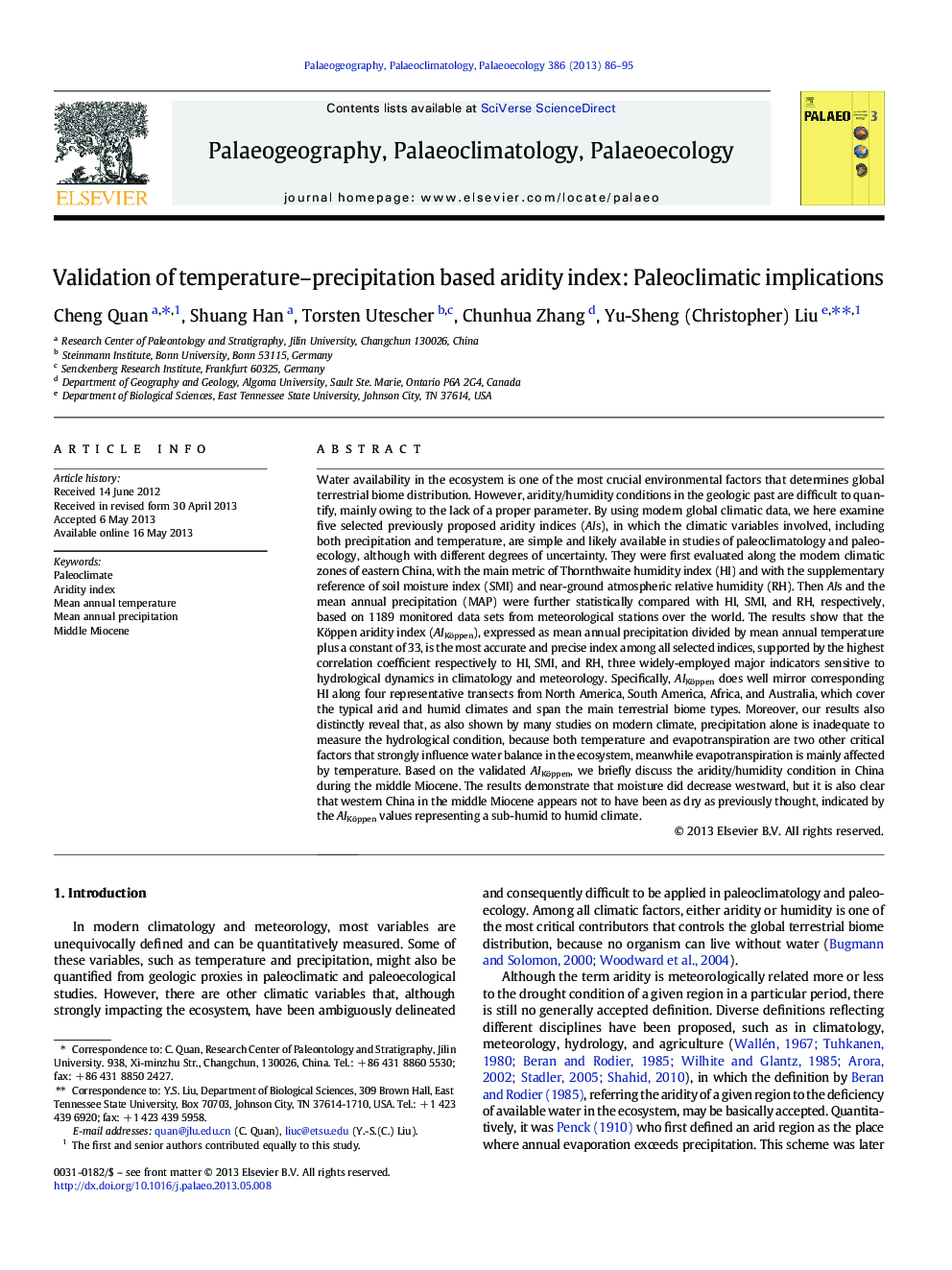| کد مقاله | کد نشریه | سال انتشار | مقاله انگلیسی | نسخه تمام متن |
|---|---|---|---|---|
| 6350295 | 1622203 | 2013 | 10 صفحه PDF | دانلود رایگان |
عنوان انگلیسی مقاله ISI
Validation of temperature-precipitation based aridity index: Paleoclimatic implications
ترجمه فارسی عنوان
اعتبار سنجی شاخص بارندگی بر اساس درجه حرارت بارش: پیامدهای پالئولیسم
دانلود مقاله + سفارش ترجمه
دانلود مقاله ISI انگلیسی
رایگان برای ایرانیان
کلمات کلیدی
موضوعات مرتبط
مهندسی و علوم پایه
علوم زمین و سیارات
فرآیندهای سطح زمین
چکیده انگلیسی
Water availability in the ecosystem is one of the most crucial environmental factors that determines global terrestrial biome distribution. However, aridity/humidity conditions in the geologic past are difficult to quantify, mainly owing to the lack of a proper parameter. By using modern global climatic data, we here examine five selected previously proposed aridity indices (AIs), in which the climatic variables involved, including both precipitation and temperature, are simple and likely available in studies of paleoclimatology and paleoecology, although with different degrees of uncertainty. They were first evaluated along the modern climatic zones of eastern China, with the main metric of Thornthwaite humidity index (HI) and with the supplementary reference of soil moisture index (SMI) and near-ground atmospheric relative humidity (RH). Then AIs and the mean annual precipitation (MAP) were further statistically compared with HI, SMI, and RH, respectively, based on 1189 monitored data sets from meteorological stations over the world. The results show that the Köppen aridity index (AIKöppen), expressed as mean annual precipitation divided by mean annual temperature plus a constant of 33, is the most accurate and precise index among all selected indices, supported by the highest correlation coefficient respectively to HI, SMI, and RH, three widely-employed major indicators sensitive to hydrological dynamics in climatology and meteorology. Specifically, AIKöppen does well mirror corresponding HI along four representative transects from North America, South America, Africa, and Australia, which cover the typical arid and humid climates and span the main terrestrial biome types. Moreover, our results also distinctly reveal that, as also shown by many studies on modern climate, precipitation alone is inadequate to measure the hydrological condition, because both temperature and evapotranspiration are two other critical factors that strongly influence water balance in the ecosystem, meanwhile evapotranspiration is mainly affected by temperature. Based on the validated AIKöppen, we briefly discuss the aridity/humidity condition in China during the middle Miocene. The results demonstrate that moisture did decrease westward, but it is also clear that western China in the middle Miocene appears not to have been as dry as previously thought, indicated by the AIKöppen values representing a sub-humid to humid climate.
ناشر
Database: Elsevier - ScienceDirect (ساینس دایرکت)
Journal: Palaeogeography, Palaeoclimatology, Palaeoecology - Volume 386, 15 September 2013, Pages 86-95
Journal: Palaeogeography, Palaeoclimatology, Palaeoecology - Volume 386, 15 September 2013, Pages 86-95
نویسندگان
Cheng Quan, Shuang Han, Torsten Utescher, Chunhua Zhang, Yu-Sheng (Christopher) Liu,
